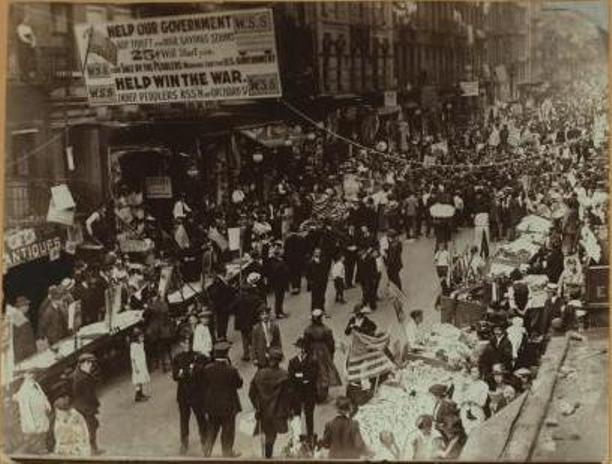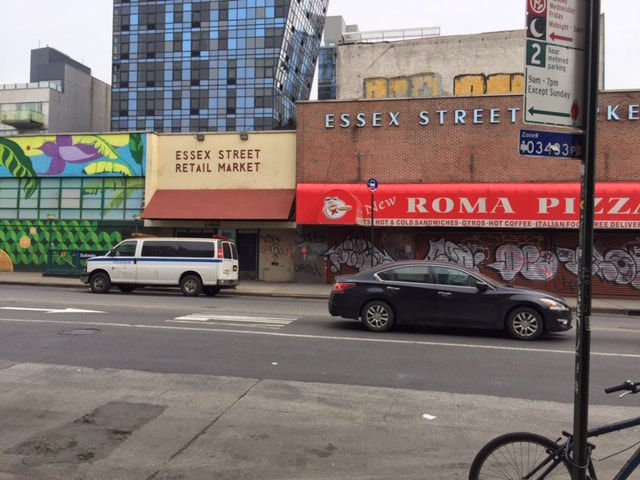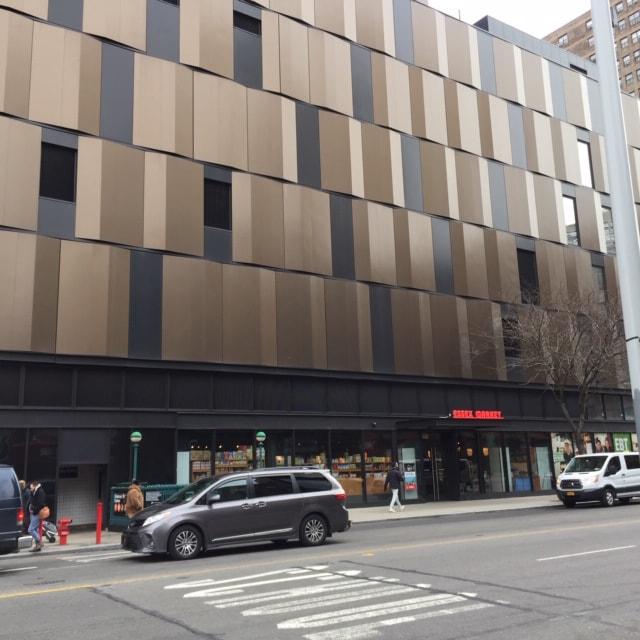|
By Laurie Lewis The first job of many newcomers to America in the late nineteenth and early twentieth centuries was selling food or other goods from a pushcart on the streets of New York City. A pushcart license cost just a few dollars, and vendors could make enough money to start their families on a new life. The pushcart peddlers served the needs of the immigrant community, too, selling necessary goods inexpensively right outside the tenement homes of hard-working residents like themselves. In 1866, four pushcart peddlers on the Lower East Side defied a law mandating that pushcarts move to a different location every half hour. These vendors stayed on Hester Street, and more pushcarts soon joined them. Outdoor markets sprang up on Hester, Orchard, Essex, and other nearby streets in the rapidly growing neighborhood, which had long been the first American home for successive waves of immigrants from different lands. By 1900, the Lower East Side was bursting at the seams. This tenement district was the most densely populated place in the world, with more than 700 residents per acre. At this point, most of the residents were Jews who had fled the harsh conditions and prejudices of East Europe. Thousands of these newcomers were pushcart vendors working in their own neighborhood. With their pushcarts clogging the congested streets of the Lower East Side, the peddlers hawked cheap fruit, pickles, fish, clothing, and household goods. A Lower East Side street with a busy pushcart market, 1917 (From the New York Public Library Digital Collection) Unsanitary conditions and traffic problems in all areas of the city with pushcart markets frequently raised concerns. But the pushcart economy was still strong in the 1930s when Mayor Fiorello LaGuardia decided it had to go. He didn’t want to put the vendors out of business; he just wanted them off the streets. With federal funds, LaGuardia established indoor markets where licensed pushcart vendors could sell their goods. On the Lower East Side, the Essex Street Market had 475 stalls in four buildings when it opened in 1940. Essex Street Market (1940-2019) This picture was taken after the market shut down. The new building in the background is Blue, a residential condominium typical of structures going up in this formerly low-rise neighborhood. As the neighborhood changed in subsequent decades, so did the Essex Street Market. The children and grandchildren of the East European Jews who had filled the tenements and markets of the Lower East Side at the beginning of the century were living the American dream, becoming economically and professionally successful and moving to more affluent surroundings. During the 1950s, Puerto Ricans moved into the Lower East Side and set up businesses in the Essex Street Market. But by the mid-1980s, as the once-overcrowded neighborhood became rundown and sparsely populated, fewer than sixty vendors remained. Then, as the new millennium began, the neighborhood took another turn. Young New Yorkers began frequenting the Lower East Side at night, enjoying the clubs that were springing up in previously abandoned buildings. They started to move into the relatively affordable housing—on the very streets that residents had been anxious to leave a century earlier. Today, pricier housing is rising, replacing or overshadowing the old tenements. And now there is a new Essex Market. Essex Market Opened in 2019 The new market is located across Delancey Street from the old indoor pushcart market, in the lower floors of a building that is part of the mixed-used, multi-structure development called Essex Crossing. The old market closed last year at the same time that the new Essex Market opened. The new market has food shops and eateries galore. But it doesn’t have any pushcarts. (See more about the new Essex Market in our February 26, 2020, blog. ) From Pushcart to Family Business Sellers often abandoned their pushcart as soon as they had enough money to open a brick-and-mortar store. Some of these stores became multigenerational retail establishments that are still thriving. Hyman Moscot started selling ready-made eyeglasses from a pushcart on Orchard Street soon after he arrived in this country in 1899. He opened an eyeglass store bearing his name in 1915. The store has moved several times, always remaining in the Lower East Side. Today, fourth- and fifth-generation Moscots work there. When Joel Russ immigrated in 1907, he initially sold mushrooms and herring from barrels on Orchard Street and quickly had enough money for a pushcart license. Seven years later, he opened a Lower East Side appetizing store (the New York term for a deli that sells bagels, smoked fish, cheese, and other dairy products but no meat). Now a fourth-generation business, Russ & Daughters has several shops and cafes in New York, as well as an online operation for people elsewhere who crave authentic Jewish New York food. March Tours Most Take a Walk New York tours cover 1 to 2 miles, last 2 to 2½ hours, and cost $25 per person. Advance registration is required. To register and to learn the meeting place, email the guide ([email protected]). Please arrive a little before the start time. Tours are cancelled if nobody has registered or if the weather is extreme; if in doubt, call or text Laurie (917-306-2868). Greenwich Village: In the Footsteps of Writers Many writers and other creative people have called Greenwich Village home. On this tour, you’ll meander through charming Village streets and peek into hidden cul-de-sacs as you learn where some famous writers—including Edna St. Vincent Millay, e.e. cummings, and Edward Albee—lived. Maybe the Village aura will spark your own creativity! Laurie gives this tour on Tuesday, March 10, at 1 PM. To reserve a place and to learn the meeting location, email her at [email protected]. Central Park: Highlights of the Southern Half In the popular southern half of Central Park, you’ll recognize some of the most filmed and photographed sights in New York, including Strawberry Fields, the Sheep Meadow, and Bethesda Terrace. The park beckons in all kinds of weather. We'll celebrate Spring on this tour, and you'll be able to see some design elements that are hard to detect in other months through the foliage and visiting crowds. Take a walk through the southern half of Central Park on Friday, March 20, at 1 PM. Please email the guide ([email protected]) to register and to learn the meeting location. Hidden Treasures of the Financial District Walking through the canyons of Wall Street, you can easily miss gems hidden in plain sight, including relics of the Dutch and English colonial periods and park-like oases. Discover these secrets while seeing major attractions like the New York Stock Exchange and the Charging Bull statue. You’ll realize that the Financial District has a lot more going for it than stock trades and megadeals. Laurie offers this tour on Sunday, March 29, at 1 PM. To reserve a spot on the tour and to learn the meeting location, email her at [email protected]. March Tours
Comments are closed.
|
Archives
April 2024
|




